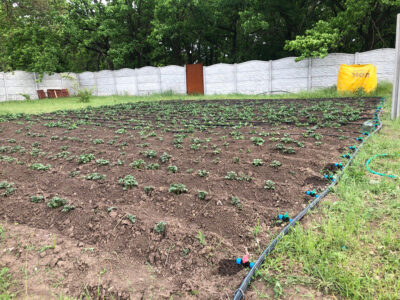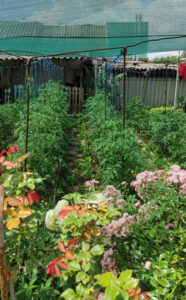How can food security be achieved with a growing population while protecting natural resources and fair and adequate income for farmers and future generations?
According to the United Nations, the global population is set to skyrocket to 9.8 billion by 2050 and a staggering 11.2 billion by 2100. With this surge in population, the challenge of maintaining food security becomes increasingly pressing. Yet, in the face of the ongoing effects of global warming in 2024, creating a steady and secure food supply has become a complex puzzle.
The stark reality is that food insecurity is on the rise. By June 2022, 345 million people in 82 countries were grappling with the harsh consequences of insufficient food access. Factors like the conflict in Ukraine, disruptions in supply chains, and the economic aftermath of the COVID-19 pandemic have collectively led to soaring food prices, making it even more challenging for vulnerable populations to secure their daily meals.
Climate change is one of the biggest contributors to this crisis. As global warming changes weather patterns, we witness more frequent and intense heat waves, heavy rainfall, and droughts.
However, the way we produce food is making the situation worse. Surprisingly, it has been estimated that the global food system is responsible for roughly one-third of greenhouse gas emissions, following closely behind the energy sector. The food system is even considered the main source of methane emissions and biodiversity loss. Considering this alarming situation, more and more food security experts are shifting towards sustainable agriculture.
Sustainable agriculture is a philosophy and set of practices that collectively satisfy three different conditions:
- Respect for the environment and protection of natural resources;
- Ensuring fair and adequate income for farmers in modern conditions;
- Ensuring future generations can live off agriculture and have a suitable and sufficient income.
Let’s find out more about why there is an alarming need for the food industry to shift towards sustainable agriculture and how we can do it.
The Green Revolution: A Double-Edged Sword
In the mid-20th century, the world faced a pressing challenge: how to produce more food for a growing population. The Green Revolution emerged as a response, introducing significant changes to agricultural practices. It was led by Nobel Prize winner Norman Borlaug.
The Green Revolution focused on high-yielding varieties (HYVs) of crops specially bred to resist pests and diseases. This innovation led to a substantial increase in crop yields, providing a vital boost to global food production. Countries like India and Mexico experienced notable improvements in food security and a decrease in hunger.
Farmers were excited to try the new high-yielding crops, attracted by promises of improved productivity and economic gains. The movement also emphasized advancements in irrigation, offering farmers more control over water distribution. This not only contributed to increased crop output but also provided a more reliable food supply. To complement these changes, synthetic fertilizers containing essential nutrients became a key component. Nitrogen, phosphorus, and potassium (NPK) enriched the soil, promoting good crop growth.
Unintended Consequences: Environmental Impact
The Green Revolution, with its noble goal of feeding the world, accidentally brought along some environmental challenges. One major player in this unintended drama was the use of broad-spectrum herbicides and pesticides. These powerful chemicals, while effective in protecting crops from pests and weeds, left a mark on the environment. They didn’t just target the troublemakers; they affected the whole ecosystem, harming beneficial insects and even seeping into water sources. This unintended consequence had a domino effect, leading to a decline in biodiversity – the variety of life that makes our planet livable for humans.
Another ‘accidental’ consequence came from an everyday farming practice: tilling. Regularly turning over the soil might seem like a routine chore for farmers, but it turned out to have ecological consequences. Continuous tilling led to soil degradation, stripping away essential nutrients and disrupting the natural balance of the soil ecosystem. This meant that over time, the soil became less fertile, affecting the long-term productivity of the land. The unintended toll on the environment was clear: a vital resource, the soil, was losing its health, and the consequences were felt not just on farms but on the whole ecosystem.
Soil Health: The NPK Fertilizer Conundrum
Let’s take a closer look at how we’ve been nourishing our soil. Traditionally, farmers used natural methods like composting to keep the soil healthy. But in the era of the Green Revolution, there was a shift towards synthetic fertilizers, particularly those rich in nitrogen, phosphorus, and potassium – known as NPK fertilizers.
These synthetic fertilizers were like a shortcut to helping plants grow quickly and produce more crops. However, the convenience came at a cost. The continuous use of these fertilizers disrupted the natural balance of nutrients in the soil. It’s a bit like giving your plants too much of one thing and not enough of another, leading to an imbalance that affects the soil’s health. To calculate the balance of nutrients accurately, many use the free online calculator One Convert, which helps them understand the measurements they didn’t get used to.
This imbalance isn’t just a minor issue – it contributes to soil degradation. Think of it as the soil losing its natural strength and resilience over time. Why does this matter? Because healthy soil is the foundation of our food production. If it becomes tired and depleted, our crops suffer, and so does our ability to produce the food we rely on.
Current Challenges in Conventional Farming
Here are some of the ways that traditional farming is affecting the environment and indirectly our lives without us even knowing it:
- Lack of Sustainability Education The most significant barrier to creating sustainable agriculture is the need for more sustainable agriculture research and education, and the second biggest is the lack of funds among farmers. On the one hand, farmers may need to be made aware of the consequences of not adopting sustainable farming, so they continue to use old traditional methods that degrade natural resources and pollute the environment.
- Environmental Degradation Traditional farming methods often involve practices like excessive use of synthetic fertilizers, pesticides, and regular tilling. These practices contribute to environmental degradation by depleting soil quality, compromising biodiversity, and contaminating water sources. The long-term impact affects us all, as degraded ecosystems struggle to provide essential services like clean water and fertile soil.
- Erosion and Loss of Topsoil Continuous plowing and inadequate soil conservation methods lead to erosion, causing the loss of valuable topsoil. Topsoil is crucial for plant growth and water retention. As it erodes, it takes away essential nutrients, impacting the fertility of the land. This process not only reduces agricultural productivity but also contributes to other issues like sedimentation in water bodies, affecting water quality.
- Water Scarcity and Pollution Traditional farming practices, including inefficient irrigation methods and the use of chemical fertilizers and pesticides, lead to water scarcity and pollution. Excessive water usage strains local water sources, and runoff from fields containing agricultural chemicals contaminates waterways. This affects the communities who live near such water bodies and heavily rely on it as their only source of water.
- Greenhouse Gas Emissions Traditional farming practices lead significantly to greenhouse gas emissions. The use of synthetic fertilizers releases nitrous oxide, a strong greenhouse gas. Additionally, large-scale livestock farming associated with traditional agriculture produces methane. Both gases contribute to climate change, impacting weather patterns, agricultural productivity, and overall environmental stability.
Steps to Sustainable Alternatives for Farmers

If you’re a farmer who wants to take a step toward sustainable agriculture, then here are some tips for you to follow:
- Crop Rotation Plant different crops in a planned order on your fields. This helps prevent pests and diseases from building up in the soil, as each crop has different needs and challenges. It also keeps the soil healthier by maintaining a good balance of nutrients.
- Integrated Pest Management (IPM) Use a smart approach to control pests. Keep an eye on pests, use natural enemies like beneficial insects, and make changes in how you farm to disrupt pest habits. This way, you can reduce the need for chemical pesticides and keep a more natural balance on your farm.
- Cover Cropping Grow certain plants not for harvest but to cover and protect the soil. These cover crops prevent soil erosion, suppress weeds, and add important stuff to the soil. It’s like giving your soil a protective blanket, making it healthier for your main crops.
- Reduced Tillage Think about plowing less or not at all. This helps keep the soil structure intact and holds onto water better.
- Agroforestry Practices Agroforestry is about adding a touch of the wild to your farm. You plant trees and shrubs alongside your crops. These extra plants bring many benefits, like making the soil better, attracting helpful bugs, and making your farm stronger against weather changes. Trees also act like shields, protecting your soil from being blown away.
- Natural Fertilizers Use natural ways to feed your crops. Instead of relying too much on synthetic chemicals, try compost and organic materials. It’s like giving your soil a nutritious meal that helps it stay healthy in the long run.
- Water Conservation Methods Water conservation is about using water wisely on your farm. Methods like drip irrigation or collecting rainwater help you save water and prevent wastage. It’s making sure every drop counts, both for your crops and the environment.
Turning to sustainable agriculture practices, like being mindful of what we plant, using natural ways to manage pests, and taking care of our soil, can make a real difference. It’s not just about farmers; it involves everyone, including you and me. The food choices we make, the support we give to sustainable producers, and the awareness we raise collectively matter.
Think of it as a chance to be part of something bigger – a movement towards a more sustainable and secure food system. The choices we make today will impact not only our lives but also the lives of future generations and food security in the coming years.
Andrew Mikovski is an Anchorage-based teacher with a passion for exact sciences. He holds a degree in Physics and Mathematics and has been inspiring students for over a decade. Currently, he’s a dedicated tutor, helping students grasp complex scientific concepts. In his free time, he contributes insightful articles on science and education, sharing his expertise and love for learning with a wider audience. Andrew’s commitment to making science accessible and engaging shines through in his teaching and writing.




